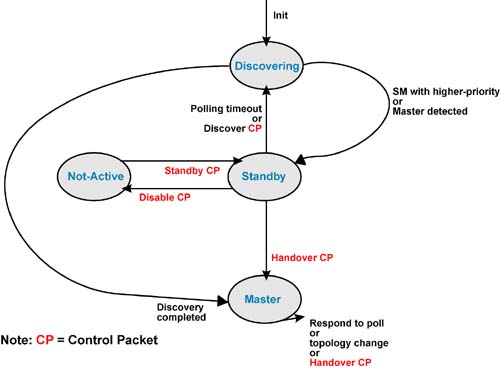Introduction to the SM States
Refer to Figure 30-1 on page 854. A SM can be in one of four possible states:
Master state. This is the state an SM is in when it is actively managing the devices in the subnet. Only one SM may be in the Master state during a given period of time.
Standby state. While in the Standby state, an SM periodically polls the Master SM to determine if it is still actively managing the subnet or has failed. More than one SM in a subnet can be in the Standby state.
Discovering state. This is the startup state for all SMs. While in this state, an SM is actively probing the subnet (described in “Discovery” on page 871) to determine the type of devices that populate the subnet and whether or not there are additional SMs within the subnet.
Not-Active state. A SM currently in the Not-Active state is passive. It does not initiate the sending of any SMPs. Rather, it quietly awaits the receipt of a SubnGet(SMInfo) or SubnSet(SMInfo) from the Master SM and responds accordingly (more later).
Figure 30-1. SM State Diagram

A SM may receive an SMP from another SM regarding an SM state change. This type of SMP is referred to as a Control Packet (CP). The current state of a SM can be read or changed by accessing the SMState element of its SMInfo attribute. The remainder of this chapter provides a detailed description of the states and Control Packets.
